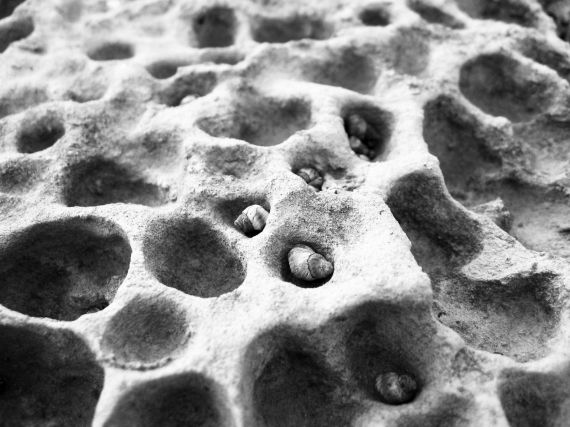After studying ‘Applied Environmental Sciences’ I decided to go with a friend for six months to New Zealand for the southern hemisphere winter. Leaving as soon as my diploma thesis (on epiphytic lichens) was written, we set off into the distance to work and travel. We chose New Zealand as our dream destination because these two islands have so many different landscapes to offer – and this is how I was able to capture this picture:

“Honeycomb Weathering” by Stefanie Boltersdorf (University of Trier, Germany), taken on the Kaikoura Peninsula, New Zealand. This photo is distributed by the European Geosciences Union under a Creative Commons License.
The photo shows honeycomb weathering on the Kaikoura Peninsula, with extends from the East coast of the South Island. Composed of mudstone and limestone, the terraces were once wave-cut platforms and have since been uplifted and deformed (during the Quaternary). The peninsula extends into the sea and encounters the relatively shallow Chatham Rise, an area of ocean floor to the east of New Zealand that was largely dry during the Cretaceous period, but now lies nearly 1000 metres underwater. This area is also one of the region’s most productive fishing grounds, a consequence of the nutrient-rich water that upwells along the coast. At low tide, the ocean gives way to a rocky floor, which is easily navigable by foot for quite some distance – and from there you can have a better view of the local seals and seabirds. At this spot, a branch of the Southern Alps, the so-called Seaward Kaikoura Range, comes close to the sea.
Very early in the morning, after sleeping next to the sea and having breakfast in our small van, ‘Berty’, the tide was very low and we took the opportunity to go for a walk. It was on this adventure we found this stunning structure, peppered with small molluscs that were sheltering in the eroded depressions. These depressions are a consequence of honeycomb weathering – a process initiated when salt meets porous rock. Sea spray delivers salt to the rocks, which, after the water has evaporated, is deposited in the pore spaces. Over time, the salt crystals push the minerals apart and weaken the rock. Small pockets collect seawater and erode into ever-larger depressions, eventually creating this marvellous honeycomb structure.
Although I have been dealing with epiphytic lichens during my diploma thesis, I remained true to them, even after my trip. After my return, and inspired by my trip to the highly lichen-rich New Zealand, I started my PhD thesis – investigating a method of quantitatively and qualitatively assessing nitrogen deposition in lichens, with the help of stable isotopes.
By Stefanie Boltersdorf, with Geo-facts from Sara Mynott
Imaggeo is the EGU’s online open access geosciences image repository. All geoscientists (and others) can submit their images to this repository and since it is open access, these photos can be used by scientists for their presentations or publications as well as by the press and public for educational purposes and otherwise. If you submit your images to Imaggeo, you retain full rights of use, since they are licensed and distributed by the EGU under a Creative Commons licence.
